ChessBase is a personal, stand-alone chess database that has become the standard through�outthe world. Everyone uses ChessBase, from the World Champion to the amateur next door. It is the program of choice for anyone who loves the game and wants to know more about it. Start your personal success story with ChessBase and enjoy the game even more.
ChessBase 17
ChessBase is a personal, stand-alone chess database that has become the standard through�outthe world. Everyone uses ChessBase, from the World Champion to the amateur next door. It is the program of choice for anyone who loves the game and wants to know more about it. Start your personal success story with ChessBase and enjoy the game even more.
WHAT YOU CAN DO WITH CHESSBASE: Retrieve games according to openings, players and tournaments; generate tournament cross tables and full graphic statistics of players or openings; “Similarity search” shows all games with similar pawn structures, sacrifice patterns, endgame positions, etc.; “Let’s check”*: access the world’s largest database of in-depth analysis (more than 200 million positions); “Instant Analysis”: Any unannotated game is analysed almost without delay immediately on loading (optional). “Assisted Analysis”: as you enter a game, whenever you click on a piece an evaluation is produced for all its possible target squares; “Tactical Analysis” will annotate game, inserting commentary, variations and diagrams, before strong moves or errors, into a game or an entire database. It will also point out combinations, played in the game or missed, tries, attacks, initiative, and of course the latest in openings theory; Cloud analysis: you can analyse positions simultaneously with several engines from on di©erent computers running in parallel; “Deep analysis”: generates an analysis tree that changes dynamically, as with time weaker variations are dropped; automatic analysis jobs for correspondence games; “Replay Training”: Playing through a game with the notation hidden and automatic training questions with tips for each individual move. Extended reference search for openings shows increase/decrease in popularity and typical recurring endgames; merge games on the fly into an opening tree; Repertoire recommendations for every move with a single click; generate a dossier containing all available information on a specific player from the database; Preparation for opponents with recognition of their weaknesses; generate a comprehensive openings report with main and critical lines, plans and most important games; Urgent news about recently played innovations; Search for characteristic tactical positions in an opening variation single click publication of games on the Internet; Improved search mask with tactical motifs and examples for manoeuvres and material distribution; Completely new search booster for patterns and plans; print games in superb quality with diagrams and multiple columns; Crisp new 3D boards thanks to raytracing technology; automatic update of your local reference database with the weekly installments of games (one year); access to the ChessBase online database with over eight million games*, mobile access with the ChessBase Account
The most important innovations
ChessBase 17 focusses at things that, in our view, are the foremost of the program's areas of application. First of all, a lot of work has gone into functions that one only notices subconsciously, but which improve the user experience: the new ultra-high-resolution 2D board; the really crisp display of notation and lists through support of Direct 2D which runs on all recent Windows versions; and popular in more recent times: the "Dark Mode".
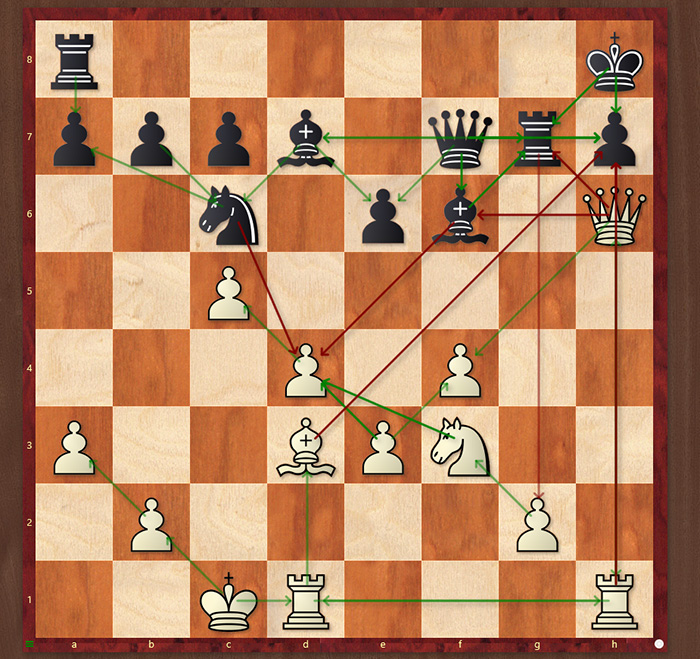
Technical improvements
Then there are many technical improvements that generally improve the program, such as: a new faster data format, with fewer files and no search booster - which overcomes limitations of the CBH format; and a fine-tuning of the database paths that solves conflicts with the Documents directory and OneDrive, so you can smoothly manage your databases outside the standard Windows directories.
Interactive search mask and much more
The smart inputting of positions is of direct chess significance. You place a few pieces onto the board, and immediately see in which games of the reference database this position fragment occurs. By clicking on a game, you can save yourself the rest of the inputting. The new search mask is also more interactive: if you enter a search criterion, the number of games in the database for which it matches is immediately displayed. This way, you know what yield to expect before you click on "OK".
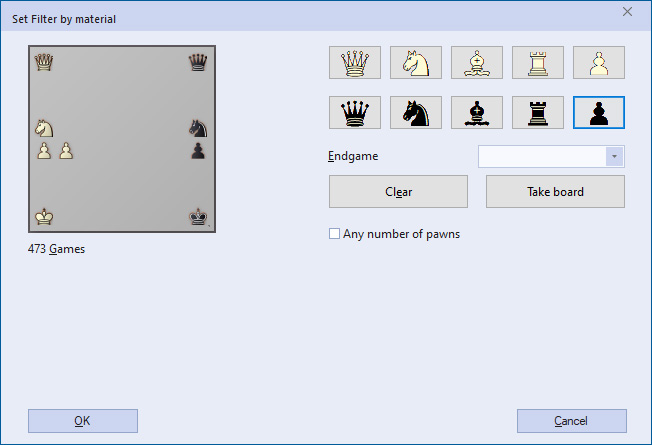
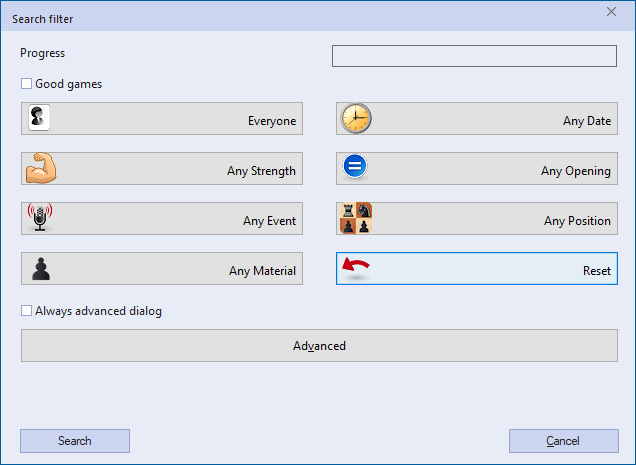
interactive searchmask
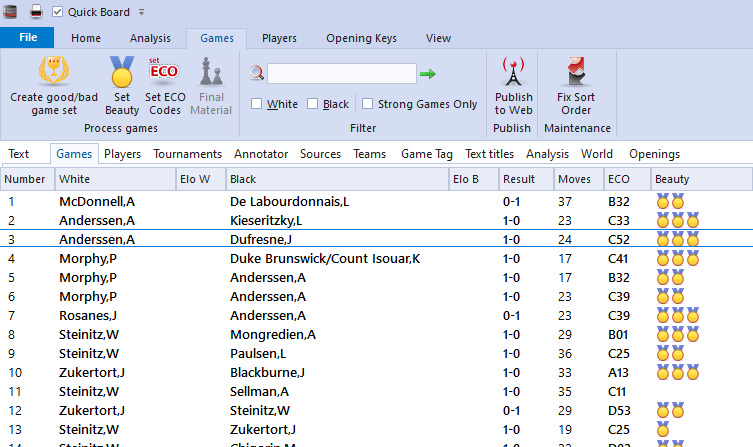
Pearl search: Find spectacular games instantly!
The new engine window
A lot has also been done in an area that is crucial for daily chess work: the engine window. Most ChessBase users probably spend 90% of their time with interactive analysis of positions. The output of engines has altered little in the last 30 years: variations, evaluations, dry as dust, done. In ChessBase 17, this has been fundamentally re-evaluated. The visual evaluation of pieces and measurement of complexity - you know from Fritz 18. The display of non-trivial threats or temptations is fancy, but also already familiar. The same goes for the training option to suppress the entire engine output, and only receive subtle tips as a stimulus to your own thinking. This is primarily intended for when watching live games.

Analysis in natural language
However, the interpretation of an engine variation in natural language is groundbreakingly new. It is often a challenge for many players to imagine what is actually happening based on just an engine variation. You see the best move, the rating, and that's it. ChessBase 17 describes in words what the variation entails
For example: In a super-sharp position, a complex variation has the strange rating "0.00". ChessBase 17 would then add "perpetual check" or "repetition of the position" and the situation would become clear. Material changes are vividly described: "White wins the queen for rook and knight"; "Black loses two pawns"; and even "The position is simplified into an endgame R+B vs R+N". There are also exciting statements like: "White gains a dangerous passed pawn on e6"; or "White sacrifices a bishop"; "Black has an attack"; "White gets the majority on the kingside"; "Both kings are insecure"; and "Manoeuvre Nd2-f1-e3-d5" etc.
Such assertions clarify the motives behind a position. If you want to understand even more of what the program means by these hints, simply move the mouse over the move indicated and the position appears on the main board. Clicking on a move copies the variation up to that move into the notation, which then simplifies the commentary
“The more colourful, the sharper” - or "Death to the exclamation mark!"

It does make a di'erence whether a position contains sharply forced variations, or several moves of almost equal value. Today's engines do not provide this information. ChessBase 17 therefore diverts a small part of the hardware resources towards a clone of the main engine, and calls this the "Buddy engine" - this only slightly impacts the computing power of the main engine. Buddy now goes over the variations, and analyses the position after each move. The variations are saved so that you can easily view them by moving your mouse cursor over on the move. Importantly, forced moves are annotated with coloured rectangles. The exclamation mark used in commenting on games for 170 years, doesn’t do justice to Buddy's search results; therefore, we now only use it for sacrifices
The colour of the rectangles indicates the evaluation. The shape shows from which depth the forcing is recognised in the calculation. Trivial tactics have vertically divided rectangles. Medium forcing divides the rectangle into two triangles from top left to bottom right. Deep forcing divides diagonally from right to left. If the upper (or left) part is green, the move wins. If the lower part is yellow, for example, the position remains roughly in the draw range after the worse alternative move. If it is red, the alternative move loses. This system may seem complex at first glance, but it has the advantage that a lot of information is signalled in one space-saving symbol. The exclamation mark has had its day. In any case, one thing is clear: the more colourful, the more forcing!
For years, we have recommended analysing with two engine variations, so that at least one forced main move can be recognised immediately. However, this costs a lot of additional computing time. ChessBase 17 marks the beginning of a renaissance of single-variation analysis. At the same time, the calculation goes much deeper. Buddy shows whether the first move is forced, and also provides the second variation.
New in ChessBase 17:
- New data format: fewer files, more functions, more comfort, more speed.
- Engine analysis renovated: Variants are automatically verbally annotated, forced continuations are recognized, “buddy heuristics” for greater search depth!
- Pearl search: Find spectacular games instantly! Beautiful games are marked in the database list.
- Optimised program interface: high-resolution 2D board, faster graphics.
- New clearer search mask: material & positional searches simplified, immediate feedback on expected results.
- Intelligent position input: when setting up pieces, you are shown the games where those positions occur.
- Dozens of detail improvements for improved usability, e.g. automatic loading of the last edited game.
- Control via One-Drive: all database paths can be set in the options dialogue.
- Newly structured game notation: with intelligent folding and symbols.
- Modern integrated browser for all database texts.
- More insight: Visualisation of attack correlations (optional).
- Dark Mode: darkened program interface.
*) Access via PREMIUM ChessBase Account
Big Database 2023
The Big Database 2023 contains more than 9.75 million games from 1560 to 2022 in the highest ChessBase quality standard. From world-class tournaments, youth or senior world championships to amateur open tournaments: with this database, every chess player is comprehensively informed.
ChessBase Magazine taster package
Try out ChessBase Magazine now and secure your ChessBase-Shop.com voucher! Order the ChessBase Magazine taster package! Read ChessBase Magazine for 6 months (= 3 issues) for the special price of only 49.90 € (instead of 59,85 € for buying them individually).
If you do not contact us after receiving the 3rd issue, you will continue to receive the ChessBase Magazine in the annual subscription (6 issues for 99,70 € instead of 119,70 € in single sale). You can cancel the annual subscription at any time. Money already paid for issues not yet delivered will be refunded.
The magazine for professional chess
 Many annotated games as well as videos in Fritztrainer format from top players such as Anand, Carlsen, Kramnik, Caruana, Aronian, Gelfand, Karjakin, Kamksy, Radjabov and Shirov.
Many annotated games as well as videos in Fritztrainer format from top players such as Anand, Carlsen, Kramnik, Caruana, Aronian, Gelfand, Karjakin, Kamksy, Radjabov and Shirov.
In every issue 11 to 15 opening reports from top class authors. What is really essential about every subject is explained in compact form. The opening surveys consist of an introduction and several annotated games in which the authors treat the subject in a way which is both of a high level and yet user-friendly.
Tactics: Bundesliga player Oliver Reeh selects nice tactical exercises from the latest tournaments and you can see how you measure up against the clock. In addition, on a video the author offers you a deeper insight into the way combinations arise and how to find them.
Strategy: GM Dorian Rogozenco explains the baic ideas of a strategical motif in a video and provides a traning database on the subject with several training tasks.
Endgames: Hamburg Grandmaster Karsten Müller is acclaimed worldwide as one of the greatest experts in the endgame. In his contributions he analyses the most interesting endgames of the previous two months and demonstrates in video format the most beautiful endings.
The opening trap: Editor in chief and Grandmaster Rainer Knaak presents a subtle opening trap in every issue.
And the best of all: You save on the ready cash. The ChessBase Magazine subscription costs approx. 20% less than buying the individual issues.
Act now and get your 10 € voucher for the ChessBase Shop!*
Programmed to win with ChessBase Magazine
Interactive and efficient. That is the trademark of the newly developed Fritz-Trainer-Format which was introduced with ChessBase Magazine #154 in June 2013. The new training concept brings two major improvements over the previous video format:
- The spectator is drawn actively into the training process, i.e. he or she is challenged to reply to a training question by entering the move which is the solution. It is only when that has been done that the training continues.
- There is feedback for every move entered, either in the form of a confirmation or in the form of a challenge to have another try. And if you have only found the second best move, there is frequently some comment about your idea.
One of the first authors to make use of this new format to help you in your work is Daniel King. For his “Move by Move” column, the English player always prepares a complete game for training purposes.

In ChessBase Magazine #155 it is the King’s Indian game Eljanov-Baryshpolets (Kiev 2013) which is up for discussion. The trainee always has to put himself or herself in the position of the winner and find the latter’s moves. King’s trademark: instead of only dealing with the best move, a lot of plausible alternatives are also explained, sometimes including wrong moves. It is also nice to find one of the variant moves – you then learn why the move you have chosen is not so strong, thus widening your chess horizons more than by simply finding the move in the game. In addition you still have the chance to get the right answer by clicking on “Try again”.
Now it's up to you to find the right moves! Enjoy the new video training format with GM Daniel King and IM Oiver Reeh!
Free opening survey - download a sample!

Leonid Kritz: "Strange - as early as move 3" - Sicilian B30: 1.e4 c5 2.Nf3 Nc6 3.Bb5 Na5
With the line 3...Na5 the German GM Leonid Kritz presents you a repertoire idea against the popular Rossolimo Variation. With this strange knight move Black avoids the doubling of his c-pawns. White also has to waste time because his Bb5 is not optimally placed. In the ideal case, Black can later move his Na5 to c4.
How should White react to the bizarre knight move? What are the practical prospects for Black in this line?
Download the opening survey for free (CBV file for ChessBase 12/Fritz 13)...
Load extract from CBM 155 (pdf)...
IMPORTANT NOTES
6 months subscription. It is automatically renewed if no notice of cancellation has been given by either party at least one month prior to renewal.
* Bonus for new subscribers only! If you order a digital subscription you will receive the voucher key right with your order confirmation by e-mail.
** Special price for Megadatabase 2020 only for those subscriptions which started before September 01, 2019.
ChessBase Account Premium 6 Months
ChessBase Account – jederzeit und überall Zugriff auf die ganze ChessBase Welt
 Ob auf dem Flughafen, im Hotel oder zu Hause auf dem Sofa: mit dem ChessBase PREMIUM Account haben Sie jederzeit Zugriff auf die ganze ChessBase Welt: die neue ChessBase Mediathek mit hunderten Trainingsvideos, Taktikserver mit über 60.000 Aufgaben, die Eröffnungstrainings-App, Live Database mit 8 Mio. Partien, der Online-Fritz, Let's Check und Webzugriff auf playchess.com/schach.de natürlich sowieso, - all das können Sie ab sofort direkt über Ihren Webbrowser nutzen. Sie brauchen nur Internet und einen aktuellen Browser, egal ob iPad, Tablet-PC, iMac-Rechner, Windows-, Android- oder Linux-System!
Ob auf dem Flughafen, im Hotel oder zu Hause auf dem Sofa: mit dem ChessBase PREMIUM Account haben Sie jederzeit Zugriff auf die ganze ChessBase Welt: die neue ChessBase Mediathek mit hunderten Trainingsvideos, Taktikserver mit über 60.000 Aufgaben, die Eröffnungstrainings-App, Live Database mit 8 Mio. Partien, der Online-Fritz, Let's Check und Webzugriff auf playchess.com/schach.de natürlich sowieso, - all das können Sie ab sofort direkt über Ihren Webbrowser nutzen. Sie brauchen nur Internet und einen aktuellen Browser, egal ob iPad, Tablet-PC, iMac-Rechner, Windows-, Android- oder Linux-System!
Playchess.com: Der offizielle Schachserver des deutschen Schachbundes
· Jeden Tag 20.000 Schachfreunde treffen: Spielen & Zuschauen
· Freundschaftspartie und Wertungspartien mit verschiedenen Bedenkzeiten
· Spielstärkemessung mit persönlicher Wertungszahl „Playchess ELO“
· Weltklasseturniere live kommentiert von Daniel King, Yasser Seirawan, Maurice Ashley u.v.m.
· Live-Shows: „PowerPlay“ mit Daniel King oder „Simon says“ mit Simon Williams u.a.
· Training und Simultan mit Profitrainern und Großmeistern
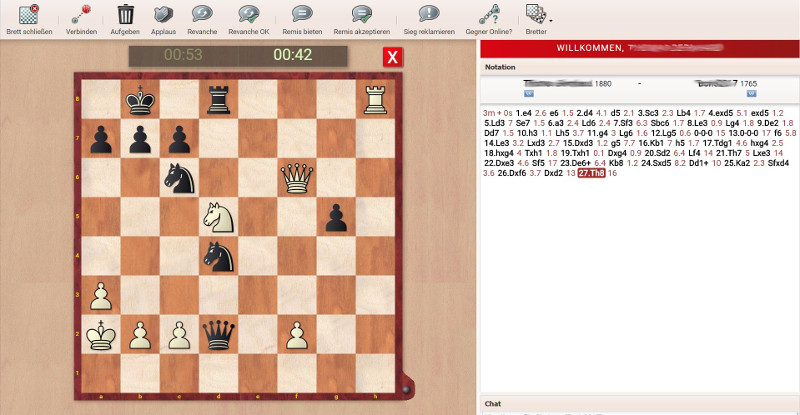
Live Database: 8 Millionen Partien online!
· Die schnellste Schachdatenbank der Welt
· Immer aktuell: wöchentliche Updates mit 5.000 Partien
· Mit LiveBook: die gesamte Eröffnungsstatistik online
· Mit Let‘s Check mit 200 Millionen Stellungsanalysen
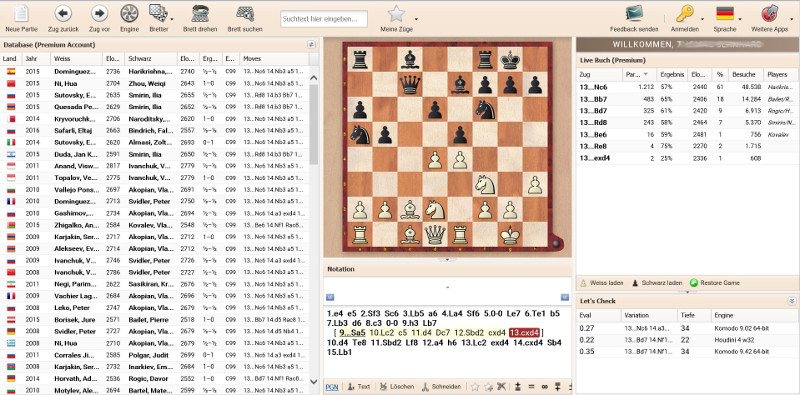
Taktik-App: Schach-Taktik trainieren! Immer und überall!
· 60.000 Taktik-Schachaufgaben
· Einfache Einzüger bis Großmeisterniveau
· Jede Stellung mit geeichtem Schwierigkeitsgrad
· Auswertung mit persönlicher Wertungszahl („Taktik-ELO“)
· Kein Stress: Lösen ohne Uhr! Nach der Lösung Zeit für eigene Analysen
· Fritz hilft: Analyse mit zugeschalteter Fritz-Engine im Browser!
· NEU: Taktik-Duell. Wer löst die Aufgaben am schnellsten?
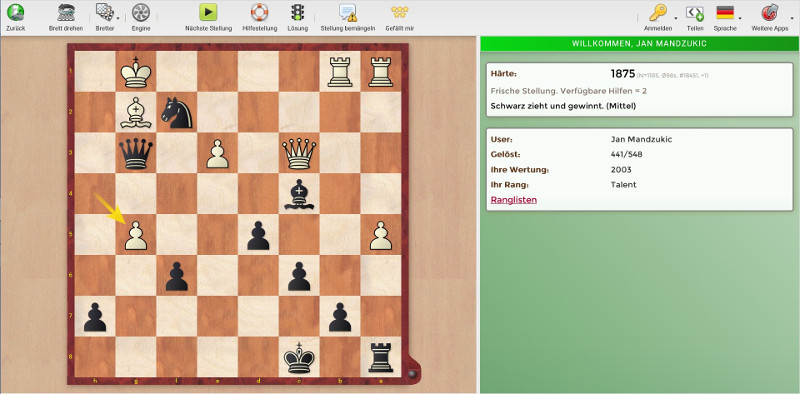
VIDEO: Privatstunden bei den Meistern
· Über 13.000 Schachvideolektionen online (ca, 6.500 Std. Spielzeit)
· Training von Eröffnung bis Endspiel, Shows, Interviews, Turnierreportagen
· Mit Top-Moderatoren und Spitzen-Autoren: Daniel King, Simon Williams, Mihail Marin, Rustam Kasimdzhanov, Yannik Pelletier u.v.m.

Openings App: Eröffnungsrepertoire aufbauen und einüben!
· Einfacher Repertoireaufbau durch Anklicken von Zügen
· Perfekte Unterstützung aus Live Database, LiveBook-Statistik und Let’s Check Engine-Analysen
· Lernen der Varianten im „Drill“-Modus
· Intelligente Verknüpfung mit LiveDatabase
· Tipp: mobil lernen auf dem Smartphone!
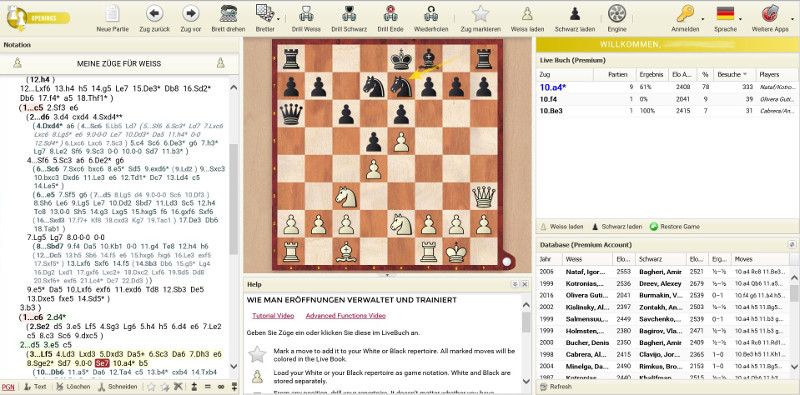
Fritz online: spielen & gewinnen!
· 5 Level: Anfänger bis Großmeister
· Interaktive Hilfe: mit Klick auf Figur dezente Hinweise
· Kein Stress: es wird ohne Uhr gespielt!
· Keine Programminstallation!
· Außerdem: Analyse, Rechentraining, LiveBook und automatische Partienspeicherung
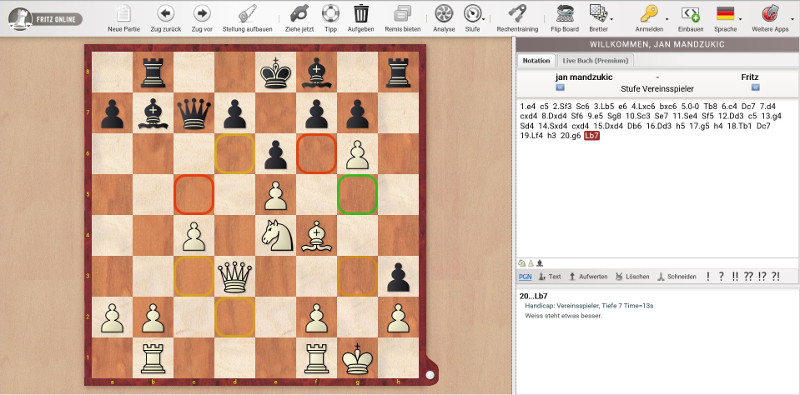
MyGames Cloud: Deine Partien und Analysen – immer im Zugriff!
· Die eigenen Partien immer dabei
· Sicherheit vor Datenverlust!
· Individuelle Analysen mit browserbasierter Fritz-Engine
· Alle Partien aus playchess.com automatisch gespeichert
· Zugriff auf das Eröffnungsrepertoire mit LiveBook
Online-Update Reference Database 2023
Activation key for automatic update of your reference database in Chessbase 13, 14, 15, 16 and 17.
Attention: This online update service 2022 is also included in the Mega Database 2023!







 Many annotated games as well as videos in Fritztrainer format from top players such as Anand, Carlsen, Kramnik, Caruana, Aronian, Gelfand, Karjakin, Kamksy, Radjabov and Shirov.
Many annotated games as well as videos in Fritztrainer format from top players such as Anand, Carlsen, Kramnik, Caruana, Aronian, Gelfand, Karjakin, Kamksy, Radjabov and Shirov.

 Ob auf dem Flughafen, im Hotel oder zu Hause auf dem Sofa: mit dem ChessBase PREMIUM Account haben Sie jederzeit Zugriff auf die ganze ChessBase Welt: die neue ChessBase Mediathek mit hunderten Trainingsvideos, Taktikserver mit über 60.000 Aufgaben, die Eröffnungstrainings-App, Live Database mit 8 Mio. Partien, der Online-Fritz, Let's Check und Webzugriff auf playchess.com/schach.de natürlich sowieso, - all das können Sie ab sofort direkt über Ihren Webbrowser nutzen. Sie brauchen nur Internet und einen aktuellen Browser, egal ob iPad, Tablet-PC, iMac-Rechner, Windows-, Android- oder Linux-System!
Ob auf dem Flughafen, im Hotel oder zu Hause auf dem Sofa: mit dem ChessBase PREMIUM Account haben Sie jederzeit Zugriff auf die ganze ChessBase Welt: die neue ChessBase Mediathek mit hunderten Trainingsvideos, Taktikserver mit über 60.000 Aufgaben, die Eröffnungstrainings-App, Live Database mit 8 Mio. Partien, der Online-Fritz, Let's Check und Webzugriff auf playchess.com/schach.de natürlich sowieso, - all das können Sie ab sofort direkt über Ihren Webbrowser nutzen. Sie brauchen nur Internet und einen aktuellen Browser, egal ob iPad, Tablet-PC, iMac-Rechner, Windows-, Android- oder Linux-System!




